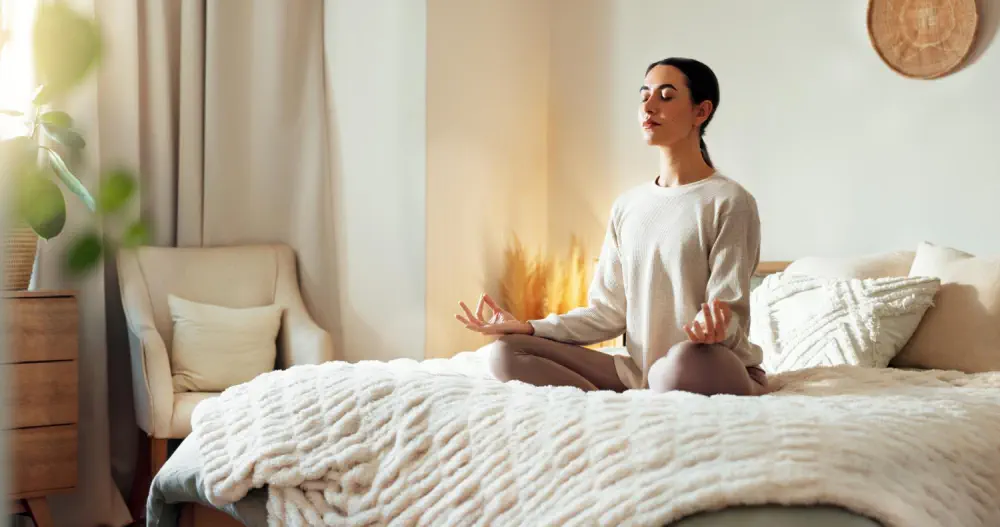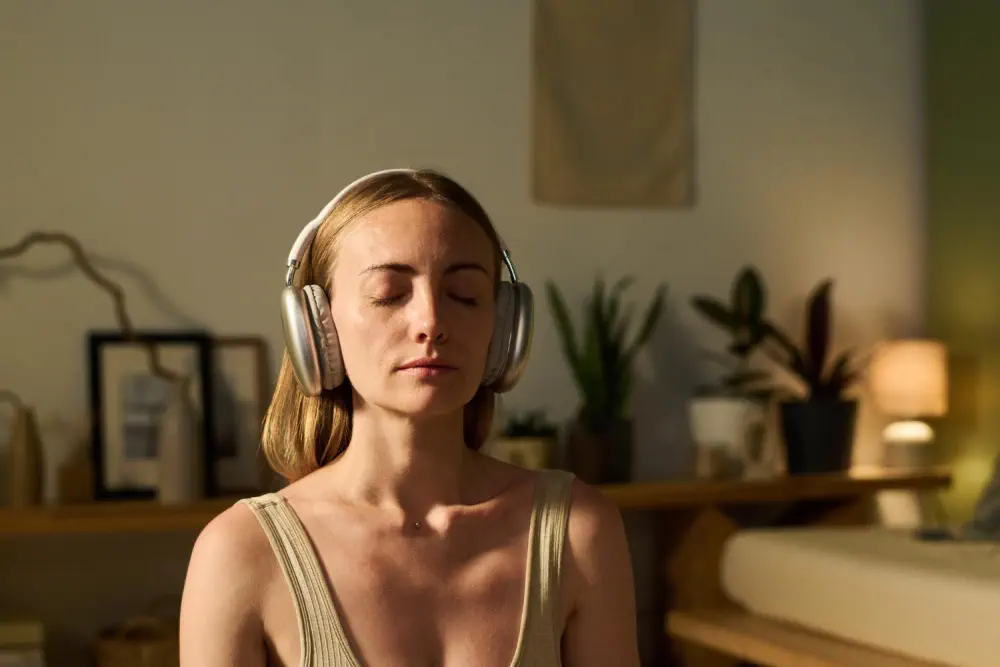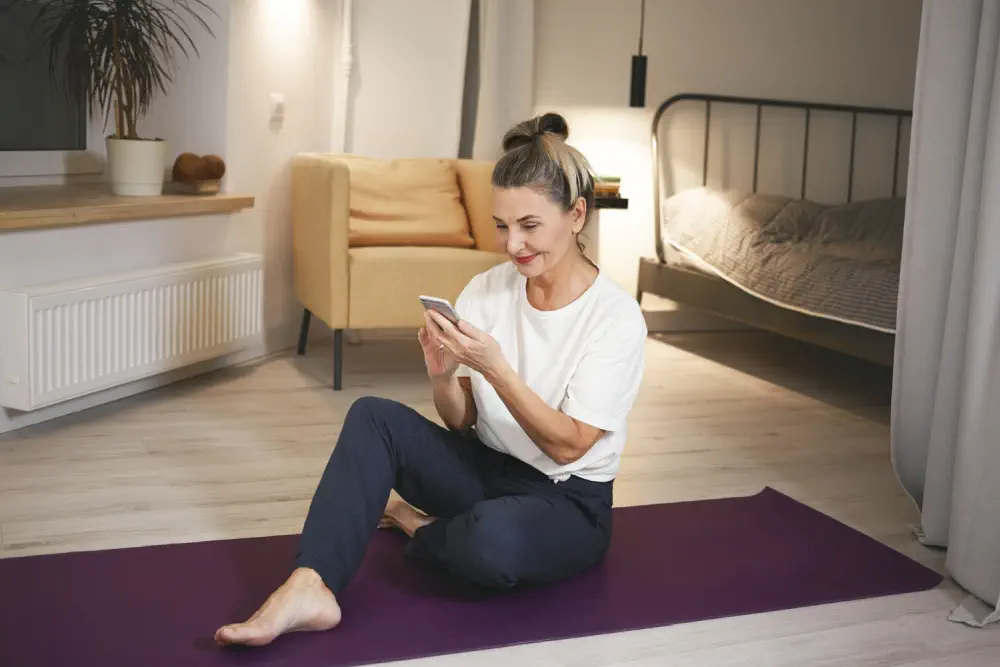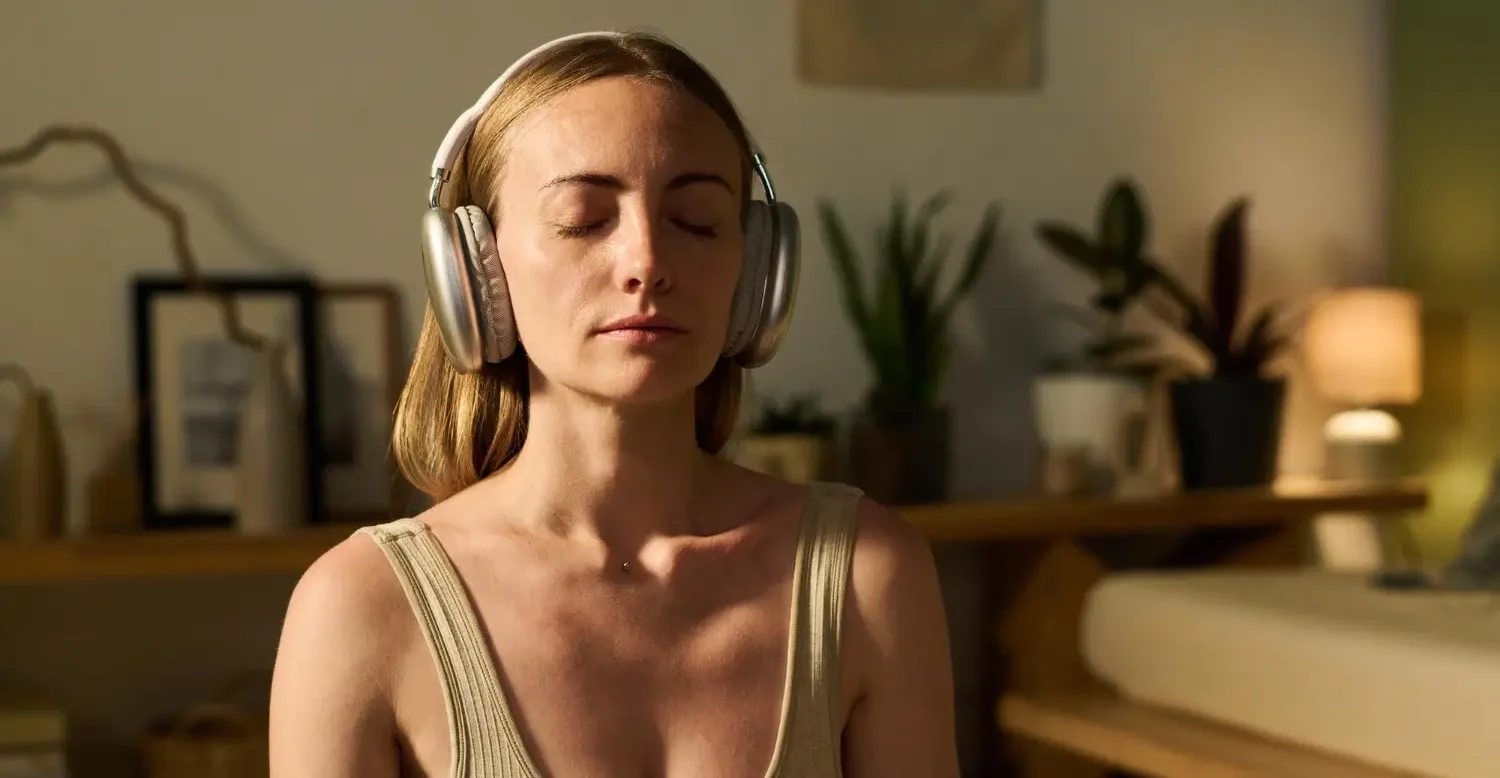We offer medical detox and multiple addiction treatment options in our
luxury treatment centres in Port Hope, Cobourg, and Ottawa.
How Does Guided Sleep Meditation Help Relieve Inner Anxiety?
You collapse into bed after another exhausting day. Your body screams for rest, yet your mind churns like a relentless machine. Worries about tomorrow's meeting blend with replays of today's conversations. Sleep feels impossibly distant.
This struggle affects millions. Research shows that 16.3% of Canadian adults (roughly 4.9 million people) meet criteria for insomnia disorder, with another 24% reporting nighttime insomnia symptoms. Anxiety at bedtime often connects to sleeping problems, as racing minds make falling and staying asleep much harder. The cycle feeds itself – poor sleep heightens anxiety, which then disrupts sleep even more.

Key Takeaway:
- Nighttime anxiety has physical roots: Your sympathetic nervous system releases stress hormones that keep you wired when you need rest most
- Guidance makes the difference: A narrator's voice provides structure when your mind feels too chaotic to meditate alone
- Your nervous system responds within minutes: The 4-7-8 breathing pattern triggers measurable changes in heart rate and stress hormones
- Body scanning releases hidden tension: Most people carry anxiety in places they don't even realize until they systematically check
- Sleep can't be forced: The harder you chase it, the more it eludes you; centring practices work differently
- Consistency amplifies benefits: Regular practice rewires your brain's response to nighttime worry over weeks, not years
Why Does Anxiety Get Worse When You Turn Off the Lights?
Darkness amplifies everything. Several factors make anxiety worse at night: reduced distractions mean anxious thoughts become more prominent in the quietness, creating a perfect storm for racing minds. Your brain, freed from daytime demands, suddenly has space to process every concern you've been pushing aside.
The physical toll shows up quickly. Tight shoulders, clenched jaw, shallow breathing – your body mirrors your mental state. Heart rate climbs. Muscles tense. When stressed, your sympathetic nervous system releases adrenaline, the "fight or flight" hormone that should help you respond to threats, but instead keeps you wired when you need rest.
Sleep deprivation weakens your immune system, clouds your thinking, and makes emotional regulation nearly impossible. Work suffers. Relationships strain. Simple tasks feel overwhelming.
How Does Guided Meditation Differ from Regular Meditation?
Guided meditation for sleep provides structure when your mind feels chaotic. A narrator's voice becomes your anchor, offering specific instructions that give your wandering thoughts somewhere to land. You're not left alone to "clear your mind" – an impossible task when anxiety runs high.
The guidance serves a crucial purpose. During guided meditation, someone walks you through the process step by step, helping you focus attention and redirect thoughts away from worries. This external support proves especially valuable for beginners who struggle with traditional meditation.
How Centring Techniques Target Sleep Specifically
Centred meditation techniques embedded in sleep-focused practices target relaxation specifically. Rather than achieving enlightenment or deep spiritual insight, your goal stays simple: calm your nervous system enough to allow sleep. The meditation may incorporate visualizations of peaceful scenes, systematic muscle relaxation, or breath-focused exercises—all designed to shift your body from high alert to rest mode.
This approach combines mental work with physical aspects like deep breathing, targeting both anxious thoughts and stress symptoms simultaneously. Your mind learns to observe worries without engaging them, while your body receives clear signals to power down.

Why Does Breathing Slowly Change Your Brain Chemistry?
Your nervous system operates like a switch with two settings. The sympathetic system drives fight-or-flight responses, while the parasympathetic system promotes rest and digestion. Meditation for deep relaxation deliberately activates that rest-and-digest mode, counteracting anxiety's grip.
The biological changes happen quickly. Meditation encourages slower breathing and lowers heart rate, creating physical conditions that support sleep. Stress hormones like cortisol decrease. Blood pressure drops. Muscle tension releases.
Brain activity shifts, too. Early research shows that even relatively brief usage can lead to benefits, from reduced depression, anxiety, and stress to improved insomnia symptoms. A comprehensive meta-analysis of 47 clinical trials found that mindfulness meditation programs produced effect sizes comparable to antidepressants in primary care settings. Neural pathways associated with worry and rumination quiet down, while areas linked to present-moment awareness strengthen.
Studies demonstrate that mindfulness meditation helps combat insomnia by evoking the relaxation response—a deep physiological shift opposite to the stress response. Your entire system recalibrates, moving from defensive hypervigilance to peaceful receptivity. This transformation doesn't require years of practice; changes begin from your very first session.
Step-by-Step Guide to Guided Meditation for Sleep
Your environment matters more than you might think. Dim the lights or turn them off completely. Adjust room temperature to something comfortable – not too warm, not too cold. Wear loose clothing that won't bind or distract. Set your phone to airplane mode if you're using it for audio guidance, eliminating the temptation to check notifications.
🍃Settle onto your back with arms resting at your sides or hands on your belly. Let your legs fall naturally hip-width apart. A supportive pillow keeps your neck aligned without strain. This position opens your chest and allows unrestricted breathing – your body's first signal that rest is coming.
🍃The 4-7-8 breathing technique anchors your nervous system. Inhale through your nose for four seconds. Hold that breath for seven seconds. Exhale completely through your mouth for eight seconds. The extended exhale activates your parasympathetic response, telling your body danger has passed. Four cycles usually suffice, though you can continue until genuine calm arrives.
🍃Now comes the body scan – a systematic release of tension you didn't realize you were holding. Your forehead and temples soften first. That tight jaw unclenches. Shoulders drop away from your ears. Notice each sensation without trying to change it; awareness itself brings release.
🍃Flow down through your arms to your fingertips. Let your chest expand fully with each breath. Soften your belly – that place where anxiety likes to hide. Your hips release, then your thighs, calves, and finally your feet. Each exhale carries tension away, vertebrae by vertebrae, muscle by muscle.
🍃Some people benefit from visualization at this point. You might place yourself under a night sky, lying in soft grass with stars scattered overhead. Warm breezes touch your skin. Crickets chirp in the distance. Engage all your senses: the earth's coolness beneath you, the sky's vastness above, the gentle sound of leaves rustling. Others prefer to simply rest in the darkness behind their eyelids.
🍃Your mind will wander – guaranteed. A thought about tomorrow's meeting surfaces. You remember something you forgot to do. This doesn't mean you're failing. Gently guide your attention back to the narrator's voice or your breath. No frustration, no self-criticism. The practice lives in this returning, this patient redirection of attention. Each time you notice and return, you're succeeding.
Here's what trips up many beginners: trying too hard. You cannot force sleep through determination or willpower. The harder you chase it, the more elusive it becomes. Instead, practice staying present and releasing thoughts as they arise. Sleep sneaks in when your guard drops, when you stop monitoring whether it's happening yet.
How Do You Build a Consistent Meditation Practice?
Quality guidance enhances your practice significantly. Search for "guided sleep meditation" resources on platforms like YouTube, podcast apps, or audiobook services. Apps like Calm and Headspace offer extensive libraries specifically designed for bedtime.
Consistency amplifies benefits. Evidence suggests regular practice of guided sleep meditation improves sleep quality, especially when combined with healthy sleep habits like maintaining consistent sleep schedules and keeping bedrooms cool, dark, and quiet.
Start with shorter sessions if full-length meditations feel overwhelming. Five to ten minutes nightly builds the habit without pressure. Over time, you can learn to guide yourself through body scans or breathing techniques, developing the ability to self-soothe into relaxation.

Taking Care of Your Whole Self
Guided sleep meditation reshapes how you approach both anxiety and rest. Rather than fighting your racing thoughts or forcing sleep through sheer willpower, you learn to work with your nervous system's natural rhythms.
Your physical and emotional health deserve this attention. Quality sleep affects every aspect of life – work performance, relationship satisfaction, immune function, and mental clarity. Meditation provides practical tools to calm your mind, relax your body, and reduce stress, leading to better sleep and lower anxiety levels.
Begin tonight. Choose one guided meditation. Create your peaceful space. Let someone's voice lead you toward the rest you desperately need. Meditation's healing power starts with a single breath, a moment of stillness, a commitment to yourself.
Sleep comes naturally when conditions align properly. Centring meditation practices and relaxation-focused meditation help create those conditions. You're not learning something new – you're rediscovering what your body already knows.
FAQ
How long does guided sleep meditation take to work?
Many people experience initial benefits during their first session, feeling calmer and falling asleep more easily. Some users report falling asleep within five minutes when using meditation apps. However, building lasting change typically requires consistent practice over two to four weeks, as your nervous system learns new relaxation patterns.
Can I use guided meditation if I've never meditated before?
Absolutely. Guided formats are particularly effective for beginners, as the narrator provides structure and direction. You don't need prior experience or special skills – just a willingness to listen and follow simple instructions for breathing and body awareness.
What if my mind keeps wandering during meditation?
Wandering minds are completely normal and expected. Meditation styles often incorporate mindfulness—focusing on the present moment with a non-judgmental mindset. Each time you notice your attention has drifted, simply return to the guidance or your breath without criticism. This returning becomes the practice itself.
Should I use meditation instead of seeing a doctor about anxiety?
While meditation serves as a practical tool for managing anxiety and improving sleep, it should not substitute professional help from mental health providers. If anxiety significantly disrupts your daily life or if sleep problems persist despite trying meditation, consult a healthcare professional for comprehensive treatment options.
How long should each meditation session last?
Start with 5-10 minutes if you're new to the practice. Most sleep-focused sessions run 15-30 minutes, though some extend to an hour. Your ideal length depends on personal preference and how quickly you typically fall asleep. Shorter sessions work fine—consistency matters more than duration.
Can I practice this technique during the day for anxiety?
Yes. The same breathing exercises, body scans, and mindfulness techniques work for daytime anxiety management. Many people use brief 5-minute sessions during lunch breaks or stressful moments. The difference is positioning—sit comfortably rather than lying down to avoid drowsiness.
Do I need special equipment or apps to start?
No special equipment is necessary. You can practice with just your breath and body awareness. However, guided recordings from apps like Calm, Headspace, or free resources on YouTube provide helpful structure, especially when starting out. A quiet space and a comfortable surface are your only real requirements.
Is it safe to combine meditation with sleep medication?
Meditation typically complements medical treatments safely, but always inform your doctor about all approaches you're using. Some people find they can gradually reduce medication dosage under medical supervision as meditation skills develop, though this decision requires professional guidance.






